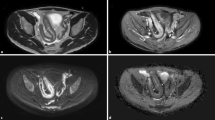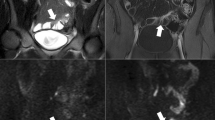Abstract
Objectives
Evaluate the ability of MR diffusion-weighted imaging (DWI) to predict patency capsule retention in Crohn’s disease (CD).
Methods
Clinical and imaging data were prospectively reviewed for 80 CD patients following patency capsule administration and MR-DWI under institutional review board (IRB) approval with informed consent. Two radiologists separately assessed the presence/absence of restricted diffusion in the distal ileum. Apparent diffusion coefficients (ADC) from three regions of interest on the ileal wall were averaged. The association between restricted diffusion and retention, and sensitivity, specificity, positive predictive value (PPV) and negative predictive value (NPV) were calculated. Ability of ADC to predict retention was assessed with receiver operating characteristic (ROC) curve analysis.
Results
Restricted diffusion in the distal ileum was associated with capsule retention (p = 0.001, p < 0.0001). Sensitivity, specificity, PPV and NPV of restricted diffusion for capsule retention were 100.0%, 46.2%, 30.0%, 100% and 100.0%, 56.9%, 34.9%, 100%, respectively, for two radiologists. Accuracy of ADC to predict retention was high (area under the curve = 0.851, p < 0.0001). An ADC of 1.47 mm2/s showed 90.0% sensitivity and 50.0% specificity for retention.
Conclusions
Sensitivity and NPV of restricted diffusion for patency capsule retention were 100%, suggesting that DWI may predict gastrointestinal tract capability to pass video camera endoscopy.
Key Points
• Capsule endoscopy enables assessment of the gastrointestinal mucosa in Crohn’s disease
• Prior patency capsule administration is recommended to evaluate gastrointestinal tract patency
• MR diffusion-weighted imaging may detect pathological constriction of the ileum
• Restricted diffusion in the distal ileum was associated with capsule retention
• MR-DWI may predict gastrointestinal tract capability to pass capsule endoscopy





Similar content being viewed by others
Abbreviations
- ADC:
-
Apparent diffusion coefficient
- AUC:
-
Area under the curve
- CDAI:
-
CD activity index
- CD:
-
Crohn’s disease
- ECCO:
-
European Crohn’s and Colitis Organization
- GEM:
-
Geometry embracing method
- IRB:
-
Institutional review board
- MR-DWI:
-
MR diffusion-weighted imaging
- MRE:
-
MR enterography
- NPV:
-
Negative predictive value
- OR:
-
Odds ratio
- PPV:
-
Positive predictive value
- RFID:
-
Radiofrequency identification
- ROI:
-
Regions of interest
- SD:
-
Standard deviation
- VCE:
-
Video capsule endoscopy (VCE)
References
Iddan G, Meron G, Glukhovsky A, Swain P (2000) Wireless capsule endoscopy. Nature 405:417
Pennazio M, Spada C, Eliakim R et al (2015) Small-bowel capsule endoscopy and device-assisted enteroscopy for diagnosis and treatment of small-bowel disorders: European Society of Gastrointestinal Endoscopy (ESGE) Clinical Guideline. Endoscopy 47:352–376
Cheifetz AS, Kornbluth AA, Legnani P et al (2006) The risk of retention of the capsule endoscope in patients with known or suspected Crohn's disease. Am J Gastroenterol 101:2218–2222
Cave D, Legnani P, de Franchis R, Lewis BS (2005) ICCE consensus for capsule retention. Endoscopy 37:1065–1067
Herrerias JM, Leighton JA, Costamagna G et al (2008) Agile patency system eliminates risk of capsule retention in patients with known intestinal strictures who undergo capsule endoscopy. Gastrointest Endosc 67:902–909
Rommele C, Brueckner J, Messmann H, Golder SK (2016) Clinical experience with the PillCam patency capsule prior to video capsule endoscopy: a real-world experience. Gastroenterol Res Pract 2016:9657053
Bourreille A, Ignjatovic A, Aabakken L et al (2009) Role of small-bowel endoscopy in the management of patients with inflammatory bowel disease: an international OMED-ECCO consensus. Endoscopy 41:618–637
Foti PV, Farina R, Coronella M et al (2015) Crohn's disease of the small bowel: evaluation of ileal inflammation by diffusion-weighted MR imaging and correlation with the Harvey-Bradshaw index. Radiol Med 120:585–594
Shenoy-Bhangle AS, Nimkin K, Aranson T, Gee MS (2015) Value of diffusion-weighted imaging when added to magnetic resonance enterographic evaluation of Crohn disease in children. Pediatr Radiol. doi:10.1007/s00247-015-3438-1
Leyendecker JR, Bloomfeld RS, DiSantis DJ, Waters GS, Mott R, Bechtold RE (2009) MR enterography in the management of patients with Crohn disease. Radiographics 29:1827–1846
Rozendorn N, Klang E, Lahat A et al (2016) Prediction of patency capsule retention in known Crohn's disease patients by using magnetic resonance imaging. Gastrointest Endosc 83:182–187
Seo N, Park SH, Kim KJ et al (2015) MR Enterography for the evaluation of small-bowel inflammation in Crohn Disease by using diffusion-weighted imaging without intravenous contrast material: a prospective noninferiority study. Radiology. doi:10.1148/radiol.2015150809:150809
Li XH, Sun CH, Mao R et al (2015) Assessment of activity of Crohn disease by diffusion-weighted magnetic resonance imaging. Medicine (Baltimore) 94:e1819
Hordonneau C, Buisson A, Scanzi J et al (2014) Diffusion-weighted magnetic resonance imaging in ileocolonic Crohn's disease: validation of quantitative index of activity. Am J Gastroenterol 109:89–98
Buisson A, Joubert A, Montoriol PF et al (2013) Diffusion-weighted magnetic resonance imaging for detecting and assessing ileal inflammation in Crohn's disease. Aliment Pharmacol Ther 37:537–545
Tielbeek JA, Ziech ML, Li Z et al (2014) Evaluation of conventional, dynamic contrast enhanced and diffusion weighted MRI for quantitative Crohn's disease assessment with histopathology of surgical specimens. Eur Radiol 24:619–629
Ream JM, Dillman JR, Adler J et al (2013) MRI diffusion-weighted imaging (DWI) in pediatric small bowel Crohn disease: correlation with MRI findings of active bowel wall inflammation. Pediatr Radiol 43:1077–1085
Kim KJ, Lee Y, Park SH et al (2015) Diffusion-weighted MR enterography for evaluating Crohn's disease: how does it add diagnostically to conventional MR enterography? Inflamm Bowel Dis 21:101–109
Sakuraba H, Ishiguro Y, Hasui K et al (2014) Prediction of maintained mucosal healing in patients with Crohn's disease under treatment with infliximab using diffusion-weighted magnetic resonance imaging. Digestion 89:49–54
Caruso A, D'Inca R, Scarpa M et al (2014) Diffusion-weighted magnetic resonance for assessing ileal Crohn's disease activity. Inflamm Bowel Dis 20:1575–1583
Dohan A, Taylor S, Hoeffel C et al (2016) Diffusion-weighted MRI in Crohn's disease: current status and recommendations. J Magn Reson Imaging 44:1381–1396
Taylor SA, Avni F, Cronin CG et al (2016) The first joint ESGAR/ ESPR consensus statement on the technical performance of cross-sectional small bowel and colonic imaging. Eur Radiol. doi:10.1007/s00330-016-4615-9
Park SH, Huh J, Park SH, Lee SS, Kim AY, Yang SK (2016) Diffusion-weighted MR enterography for evaluating Crohn's disease: effect of anti-peristaltic agent on the diagnosis of bowel inflammation. Eur Radiol. doi:10.1007/s00330-016-4609-7
Choi SH, Kim KW, Lee JY, Kim KJ, Park SH (2016) Diffusion-weighted magnetic resonance enterography for evaluating bowel inflammation in Crohn's Disease: a systematic review and meta-analysis. Inflamm Bowel Dis 22:669–679
Lin G, Ng KK, Chang CJ et al (2009) Myometrial invasion in endometrial cancer: diagnostic accuracy of diffusion-weighted 3.0-T MR imaging–initial experience. Radiology 250:784–792
Kopylov U, Yablecovitch D, Lahat A et al (2015) Detection of small bowel mucosal healing and deep remission in patients with known small bowel Crohn's disease using biomarkers, capsule endoscopy, and imaging. Am J Gastroenterol 110:1316–1323
Greener T, Klang E, Yablecovitch D et al (2016) The impact of magnetic resonance enterography and capsule endoscopy on the re-classification of disease in patients with known Crohn's disease: a prospective Israeli IBD Research Nucleus (IIRN) Study. J Crohns Colitis. doi:10.1093/ecco-jcc/jjw006
Kopylov U, Klang E, Yablecovitch D et al (2016) Magnetic resonance enterography versus capsule endoscopy activity indices for quantification of small bowel inflammation in Crohn's disease. Therap Adv Gastroenterol 9:655–663
Shrot S, Konen E, Hertz M, Amitai MM (2011) Magnetic resonance enterography: 4 years experience in a tertiary medical center. Isr Med Assoc J 13:172–177
Van den Bosch T, Valentin L, Van Schoubroeck D et al (2012) Detection of intracavitary uterine pathology using offline analysis of three-dimensional ultrasound volumes: interobserver agreement and diagnostic accuracy. Ultrasound Obstet Gynecol 40:459–463
Park SH (2016) DWI at MR enterography for evaluating bowel inflammation in Crohn disease. AJR Am J Roentgenol 207:40–48
Maccioni F, Viola F, Carrozzo F et al (2012) Differences in the location and activity of intestinal Crohn's disease lesions between adult and paediatric patients detected with MRI. Eur Radiol 22:2465–2477
Herbst M, Zahneisen B, Knowles B, Zaitsev M, Ernst T (2015) Prospective motion correction of segmented diffusion weighted EPI. Magn Reson Med 74:1675–1681
Veeraraghavan H, Do RK, Reidy DL, Deasy JO (2015) Simultaneous segmentation and iterative registration method for computing ADC with reduced artifacts from DW-MRI. Med Phys 42:2249–2260
Guyader JM, Bernardin L, Douglas NH, Poot DH, Niessen WJ, Klein S (2015) Influence of image registration on apparent diffusion coefficient images computed from free-breathing diffusion MR images of the abdomen. J Magn Reson Imaging 42:315–330
Acknowledgements
The authors wish to thank Shifra Fraifeld, an independent medical writer, for her editorial assistance during the preparation of this manuscript.
Author information
Authors and Affiliations
Corresponding author
Ethics declarations
Guarantor
The scientific guarantor of this publication is Dr Michal Amitai.
Conflict of interest
The authors of this manuscript declare no relationships with any companies whose products or services may be related to the subject matter of the article.
Funding
This study was partially funded by a generous grant from the Leona M. and Harry B. charitable trust.
Statistics and biometry
One of the authors (EK) has significant statistical expertise.
Informed consent
Written informed consent was obtained from all subjects (patients) in this study.
Ethical approval
Institutional review board approval was obtained.
Study subjects or cohorts overlap
Some data from the study subjects have been previously reported. See references 11, 22–24
Methodology
• prospective data collection, retrospective analysis
• observational
• performed at one institution
Rights and permissions
About this article
Cite this article
Klang, E., Kopylov, U., Ben-Horin, S. et al. Assessment of patency capsule retention using MR diffusion-weighted imaging. Eur Radiol 27, 4979–4985 (2017). https://doi.org/10.1007/s00330-017-4857-1
Received:
Revised:
Accepted:
Published:
Issue Date:
DOI: https://doi.org/10.1007/s00330-017-4857-1




